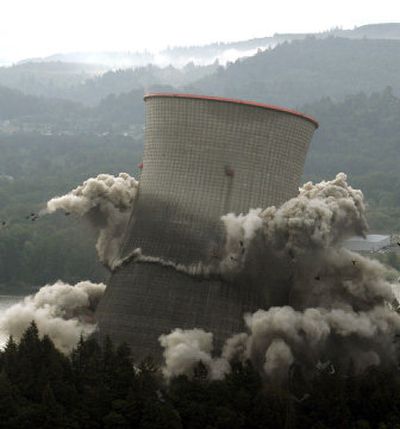Nuclear landmark toppled

RAINIER, Ore. – Demolition crews destroyed the 499-foot cooling tower at the decommissioned Trojan nuclear power plant here Sunday, eliminating a Northwest landmark and a longtime reminder of the controversy over nuclear energy.
With a rumble, the tower leaned to the side and collapsed upon itself, leaving an enormous cloud of dust and multi-ton pile of rubble. It took 2,792 pounds of dynamite but only a few seconds to bring it down.
“It was amazing,” said Wanda Obermeier, who was among the onlookers gathered on both sides of the Columbia River on Sunday morning to watch the implosion.
Portland General Electric, the utility that built and owns Trojan, ordered the tower destroyed as part of the power plant’s decommissioning.
“It was sort of bittersweet,” said Steve Nichols, PGE’s general manager at Trojan. “The bitter part we sort of addressed when it closed down. … The sweet part will be when we finish a job well-done.”
Trojan was closed in 1993 for financial and safety reasons and has been decommissioned gradually since. It remains Oregon’s only commercial nuclear power plant.
The tower was a landmark, an icon or an eyesore, depending on whom you talk to.
“It should have been left as a monument to the failure of this technology and the arrogance of those who promoted it,” said Lloyd Marbet, a longtime opponent of Trojan.
Over the years, Trojan faced a number of opponents concerned about the safety of nuclear power. Activists submitted numerous initiatives to voters and petitions to regulators to shut the plant down.
Many activists celebrated throughout the weekend, including throwing a party with cooling-tower-shaped piñatas.
Others celebrated in their own way. At the Goble Tavern, once a watering hole for Trojan employees, some guests stayed up all night celebrating the event. There were bands, camping and a T-shirt designer selling Trojan implosion memorabilia.
The massive tower dominated the landscape along the Columbia River about 40 miles north of Portland. It was a landmark that could be seen from nearby highways, including a long stretch of Interstate 5, the main West Coast corridor. It also held a lot of memories for people in surrounding areas.
“I wish they would keep it standing,” said Mike Bering, a St. Helens, Ore., resident who once worked at the plant. “I hate to see it go.”
Others, such as Jeff Garrison, were less sentimental.
“I never liked seeing it – it just didn’t fit with the landscape,” he said.
The tower was the largest to be destroyed in the nation, according to the contractor, Controlled Demolition Inc.
A small portion of the base remained, but explosives reduced most of the tower to a pile of steel and concrete rubble.
“It looks this morning like things went perfectly,” said Mark Loizeaux, president of Controlled Demolition.
Because of its size and unusually strong build, the tower is of keen interest to the nuclear power industry, Loizeaux said.
“Everybody is watching,” he said, “because at some point in time, theirs will have to come down.”
PGE estimates the plant will not be fully decommissioned until 2024. Buildings will be destroyed gradually through 2008. The spent radioactive fuel rods, which sit above ground, must be moved to a federal repository that hasn’t been developed yet.